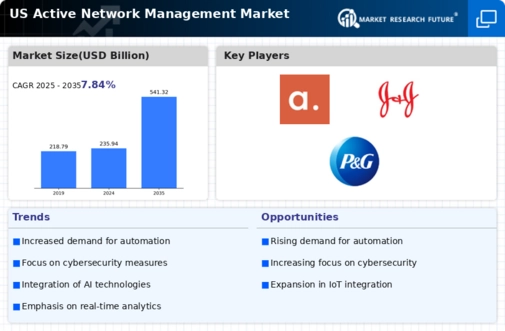Emergence of IoT Devices
The proliferation of Internet of Things (IoT) devices is reshaping the landscape of the active network-management market. With millions of devices connected to networks, the demand for effective management solutions has intensified. IoT devices generate vast amounts of data, which can overwhelm traditional network management systems. As a result, organizations are increasingly turning to active network management solutions that can handle the unique challenges posed by IoT. It is estimated that by 2025, there will be over 75 billion connected IoT devices globally, creating a pressing need for robust network management strategies. The active network-management market is thus positioned to capitalize on this trend, as businesses seek to ensure their networks can accommodate the influx of IoT traffic while maintaining performance and security.
Focus on Enhanced User Experience
The active network-management market is increasingly driven by the need for enhanced user experience. As organizations strive to deliver superior services to their customers, the performance of their networks becomes critical. Poor network performance can lead to customer dissatisfaction and loss of revenue. Recent studies suggest that a 1-second delay in page load time can result in a 7% reduction in conversions. Consequently, businesses are investing in active network management solutions that provide real-time monitoring and analytics to optimize network performance. This focus on user experience is particularly relevant in sectors such as e-commerce and online services, where customer engagement is paramount. The active network-management market is thus likely to see sustained growth as companies prioritize solutions that enhance user satisfaction.
Regulatory Compliance and Standards
The active network-management market is significantly influenced by the increasing emphasis on regulatory compliance and industry standards. Organizations are compelled to adhere to various regulations, such as the Federal Information Security Management Act (FISMA) and the Health Insurance Portability and Accountability Act (HIPAA), which necessitate robust network management practices. Failure to comply can result in substantial fines, potentially reaching millions of dollars. As a result, companies are investing in active network management solutions to ensure they meet these compliance requirements while maintaining operational integrity. This trend is particularly pronounced in sectors like healthcare and finance, where data security and privacy are critical. The active network-management market is thus likely to see continued growth as organizations prioritize compliance-driven network management.
Increased Adoption of Cloud Services
The active network-management market is witnessing a notable increase in the adoption of cloud services. As businesses migrate their operations to the cloud, the complexity of managing network resources escalates. This shift necessitates advanced network management solutions that can provide visibility and control over cloud-based environments. Recent statistics indicate that over 70% of organizations in the US are utilizing cloud services, which underscores the need for effective active network management. Companies are seeking solutions that can seamlessly integrate with their cloud infrastructure, ensuring optimal performance and security. This trend is driving innovation within the active network-management market, as vendors develop tools that cater specifically to the challenges posed by cloud environments.
Growing Demand for Network Efficiency
The active network-management market is experiencing a surge in demand for enhanced network efficiency. Organizations are increasingly recognizing the need to optimize their network resources to support growing data traffic and application performance. According to recent data, network inefficiencies can lead to a potential loss of up to 20% in operational costs. As businesses strive to improve their bottom line, the adoption of active network management solutions is becoming a priority. This trend is particularly evident in sectors such as telecommunications and IT services, where the need for seamless connectivity is paramount. The active network-management market is thus positioned to benefit from this growing emphasis on efficiency, as companies seek to implement solutions that can dynamically allocate resources and manage bandwidth effectively.














Leave a Comment